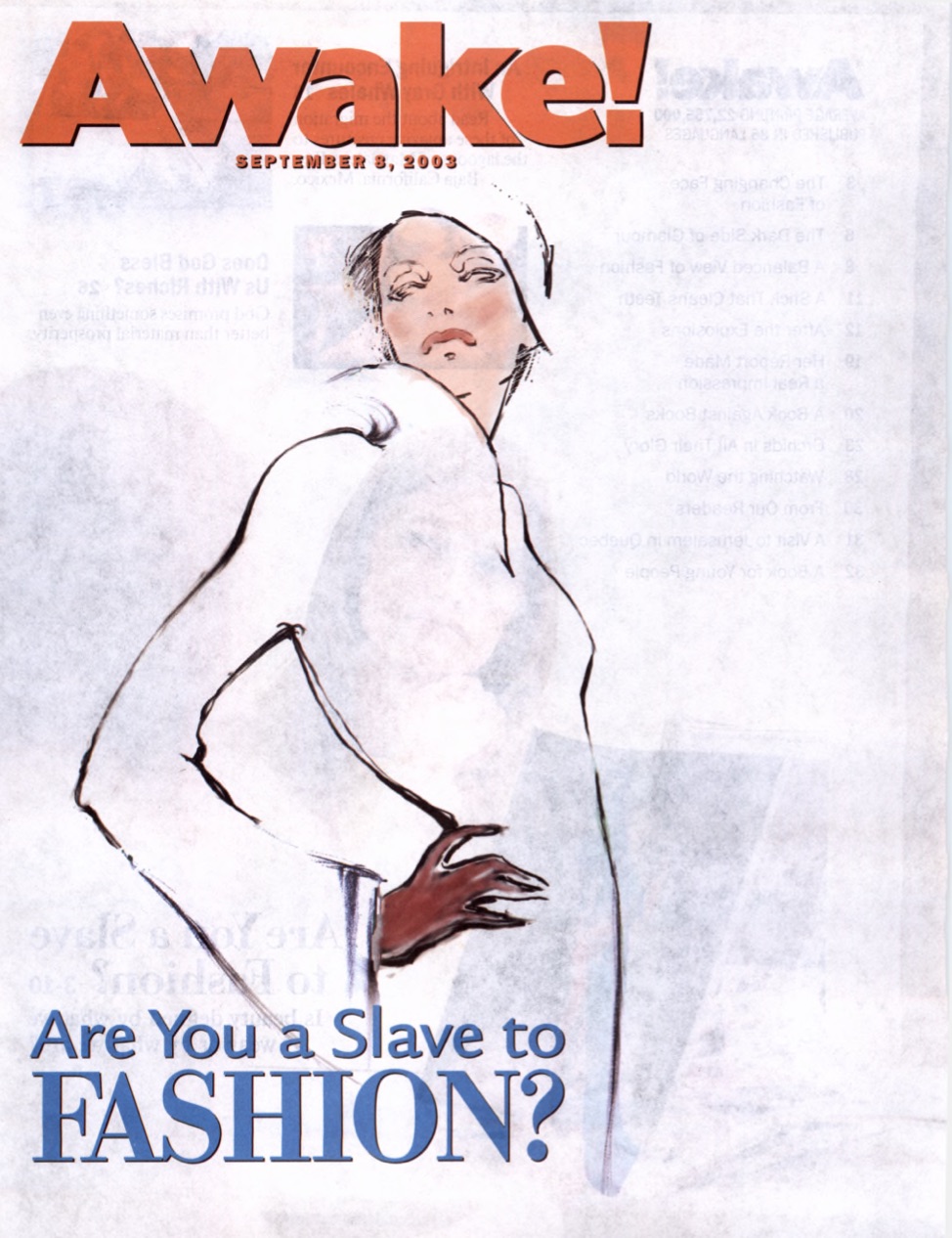home > interesting topics > clothing
Clothing and Attire of Jehovah's Witnesses
Watchtower provides strict guidance on how Jehovah's Witnesses should dress and groom. Watchtower regulates that clothing for meetings and preaching be modest business attire, and even controls casual dress standards.
This article outlines Watchtower fashion standards for meetings, preaching, conventions, Bethel, casual clothing and children. An important indicator of whether a group is using coercive persuasion to manipulate members is when it exhibits excessive levels of control over all aspects of a follower's life. Keep this in mind when considering Watchtower guidelines on clothing and attire.
Whilst strict standards when representing Watchtower at meetings and preaching have some validity, the further you get through this article, the more unreasonable, controlling and frustrating you will find the guidelines to be.
Meetings
Since meeting at the Kingdom Hall is considered part of worship, Jehovah's Witnesses are expected to comply with a high standard of dress. Interestingly, this is not clothing with spiritual connotations, but rather Watchtower's dated concept of "business attire" that aligns most closely with 1950's patriarchal, white American corporate standards. Men are expected to be clean-shaven and wear suits and ties. Women must wear modest dresses and skirts; pants are strictly forbidden.
The 2018 book Pure Worship of Jehovah includes a congregation photograph that typifies this standard of beardless males in suits and ties, and women in dresses and skirts.
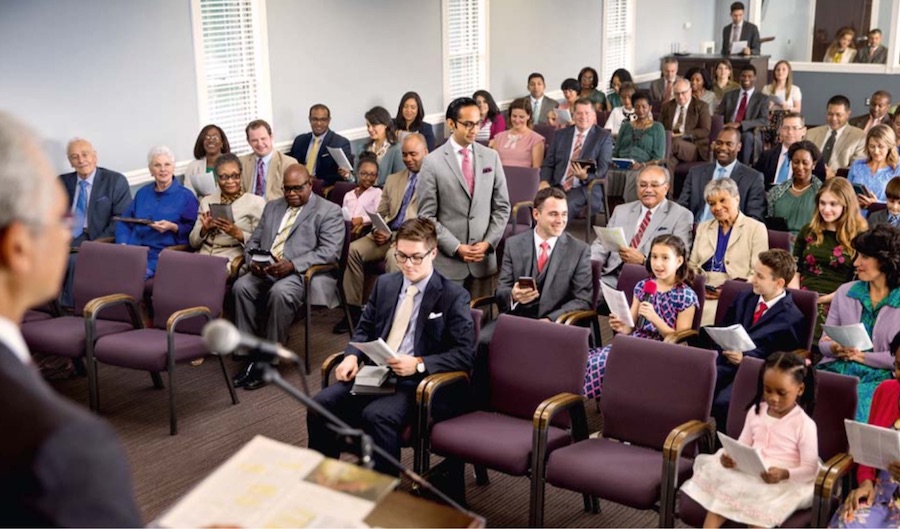
Pure Worship of Jehovah - Restored at Last! (2018) p.135
When I was living on sweltering, tropical Thursday Island, at the Northern tip of Australia, where the average temperature varied between 29C (84F) to 32C (90F), we were expected to wear trousers and ties when at meetings and preaching, and wear a suit jacket when giving talks.
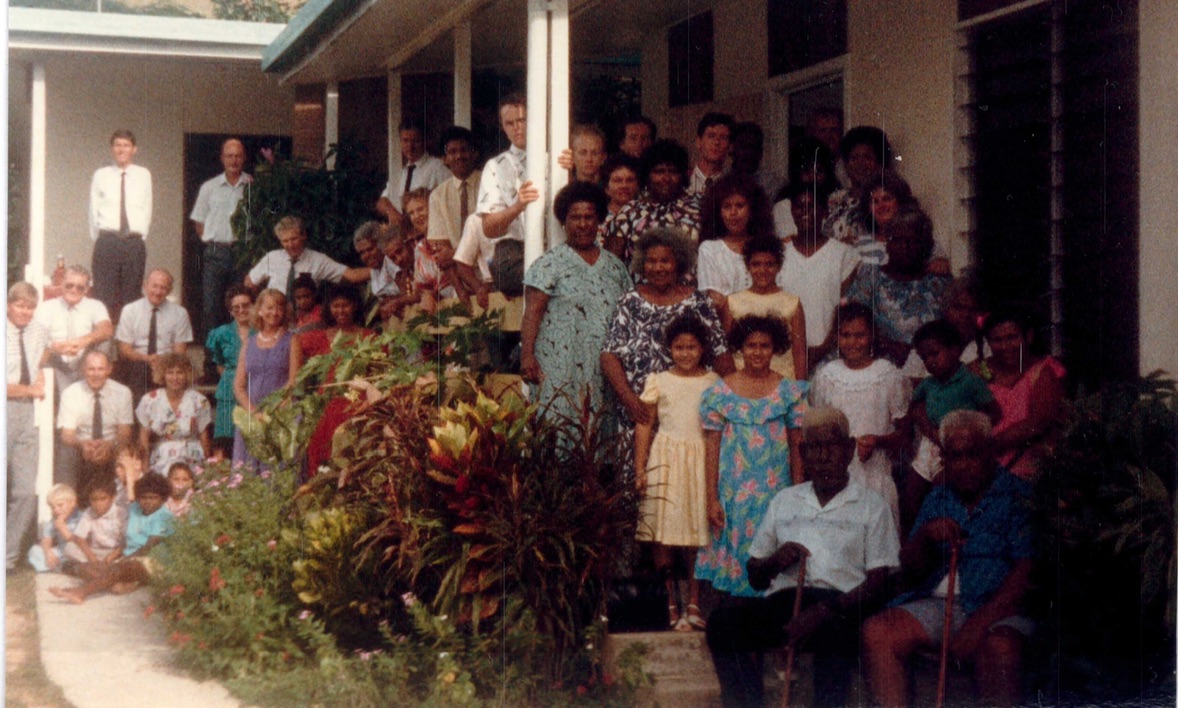
Thursday Island Congregation 1990
This went beyond standard business attire in the region, and the local bank manager once commented to me that wearing a tie was inappropriate in such heat and bank employees were not expected to wear a tie.
Preaching
The same standard of business attire is extended to preaching, as outlined in the following quote.
"We owe it to our holy God, to our spiritual brothers and sisters, as well as to the people in our territory to wear clothing that dignifies the message we bear and that brings glory to Jehovah. (Rom. 13:8-10) This is especially so when we are engaging in Christian activities, such as when we attend meetings or when we share in the preaching work. We should dress "in the way that is proper for [people] professing devotion to God."" Watchtower 2016 Sep Study ed. p.18
"At first, when the Witnesses went calling from house to house dressed up and wearing neckties, they were mistaken for Mormons, and many would not open the door. When they switched to wearing more casual attire, they were welcomed in, often for an hour or more. Now the people recognize Jehovah’s Witnesses, even though business attire is once again used in the ministry." Watchtower 1997 Aug 15 p.24
Watchtower images show brothers across all continents preaching with a tie.

Image Attribution: Who are doing Jehovah's Will Today? (2019) p.12
Conventions
Jehovah's Witnesses comply with the same formal dress code at larger events, such as special days, assemblies or conventions.
""YOU saw a lot of casual clothing, especially when it was hot," reported a Dutch newspaper regarding a meeting of church leaders. "That is not the case at the convention of Jehovah's Witnesses. . . . Boys and men wear a jacket and tie, while the girls' and women's skirt length is . . . in good taste, yet modern."" Watchtower 2016 Sep Study ed. p.17
"Therefore, even during leisure time, such as when going out to eat after the program, we should dress as befits ministers who are in the city for the purpose of attending a Christian convention and should not wear such clothing as jeans, shorts, or T-shirts." Kingdom Ministry 2007 Apr p.4
Formal attire is even expected when going for dinner or engaged in "leisure time" during convention time.
"When we attend assemblies and conventions, our dress needs to be appropriate and modest rather than reflect the extreme styles that may be common in the world. Even as we check in and out of a hotel, as well as when we enjoy leisure time before and after convention sessions, we want to avoid an appearance that is overly casual or slovenly. Thus we will be proud to identify ourselves as Jehovah's Witnesses. Yes, and we will feel free to give a witness as we have an opportunity." Watchtower 2016 Sep Study ed. p.19
Visiting Bethel
Visitors to Bethel are to abide by the same strict code as for meetings.
"Hence, when we are getting ready to participate in the field ministry or to assemble for worship at congregation meetings, circuit assemblies, and larger conventions, we should have in mind what the Scriptures say about physical cleanliness and modest appearance, so as to honor and glorify Jehovah always. The same would apply when visiting any of the branch offices of Jehovah's Witnesses. Remember, the name Bethel means "House of God."" Organised to do Jehovah's Will (2005) p.138
As illustrated in the 2008 and 2016 editions of the brochure Dress & Grooming for Visitors Touring Bethel, collared t-shirts, sneakers and formal pants on women are considered inappropriate for Bethel visitors. This is an excessive level of control, considering Bethel is predominantly an office and printing factory.
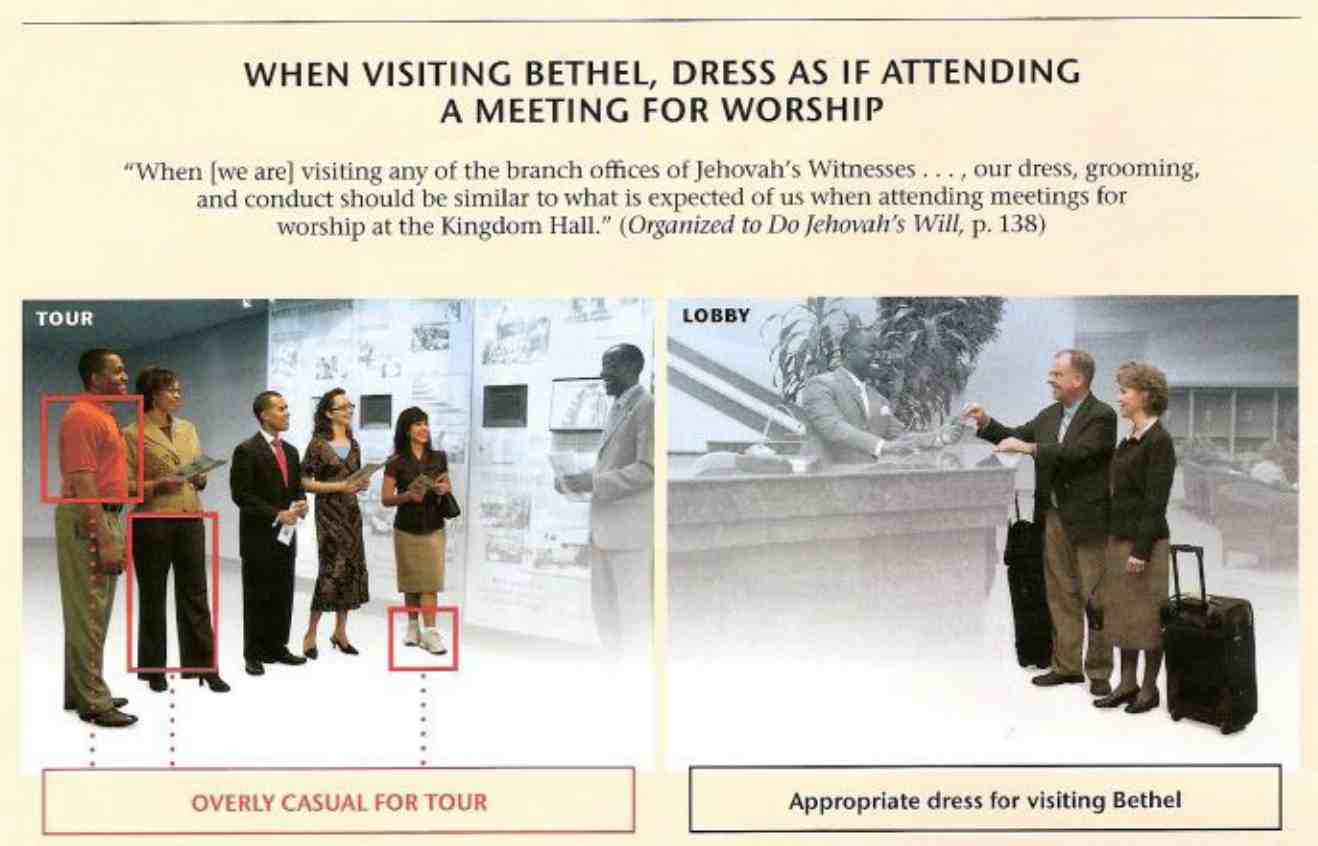
Dress & Grooming for Visitors Touring Bethel - 2008, 2016
Sisters must wear modest dresses or skirts instead of trousers to the Kingdom Hall, Bethel and when preaching. This is counter-intuitive, since formal business slacks are common corporate attire, and more modest than a dress.
Dress & Grooming for Visitors Touring Bethel - 2008,2016
Those working at Bethel are provided strict rules. A 2025 letter to Bethelites forbids extremely short, masculine hair for sisters, no tight-fitting or "sensual" clothes and brothers' beards must be neatly trimmed.
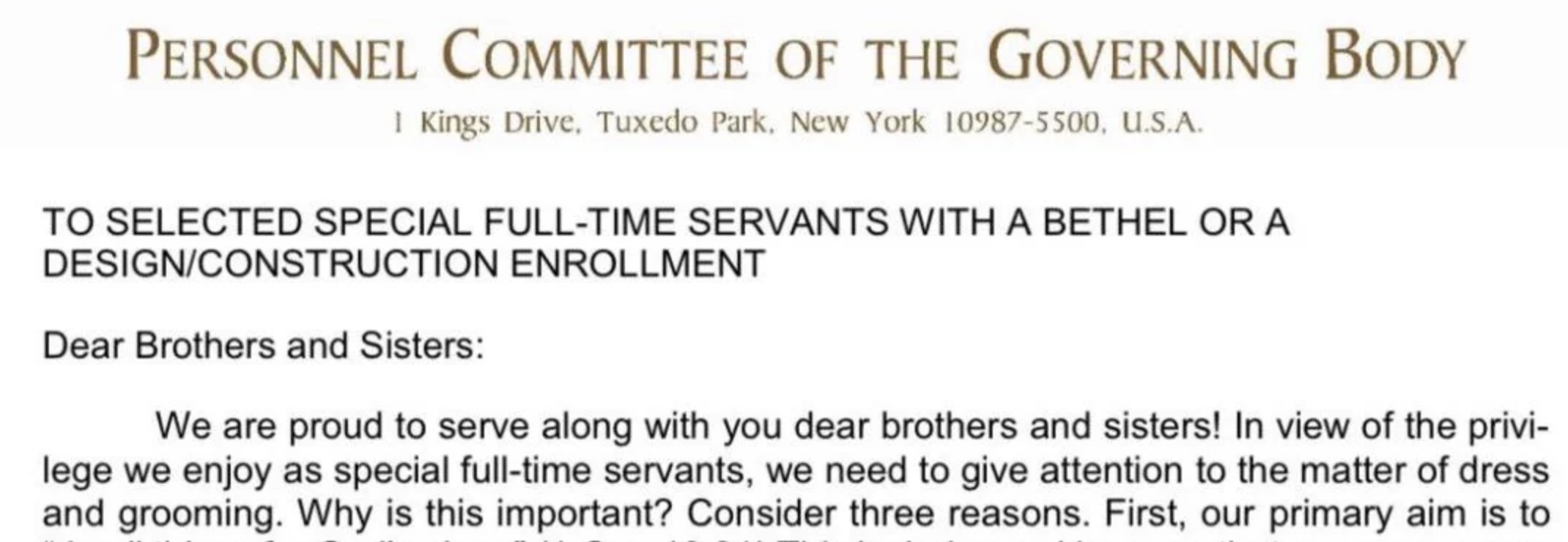

Even when enjoying recreation, Bethelites are forbidded from wearing anything overly casual.

Neckties
Jehovah's Witness males are expected to wear a tie to meetings and when witnessing, on the basis that a tie is common business attire.
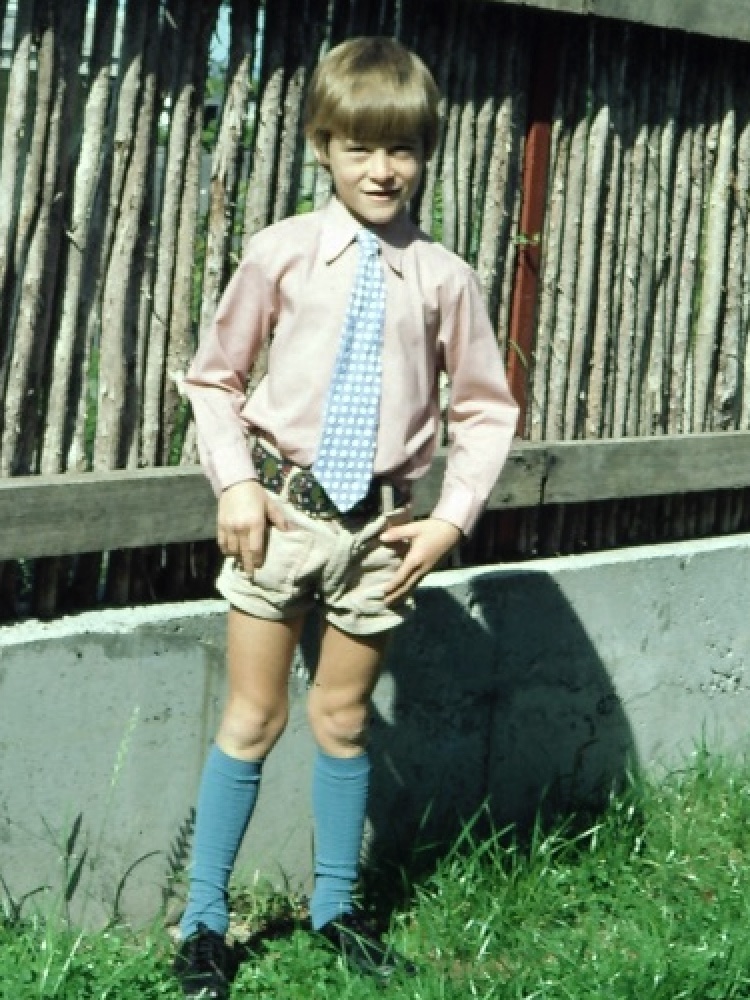
Author as a five year old dressed up to go preaching.
It is ironic for Jehovah’s Witness men to be forced to wear a necktie when the tie violates several Watchtower principles. The male necktie:
- has origins in warfare
- is an unnecessary fashion accessory
- funds the commercial world Watchtower criticises
The origin of the tie stems from war, which is condemned under Watchtower doctrine - See Jehovah's Witnesses and war. Ties were first worn in the 17th century by Croatian mercenaries during the 30 year war in France. (The Evolution of the necktie Aug 14, 2013)
The necktie is the great joke of the fashion industry. It is one of the few items of clothing that serves no useful purpose, whilst being costly and uncomfortable to wear. The fashion industry convinces men to constantly update their ties to keep up with the latest fashion in patterns and widths, with sales peaking at $1.3 billion dollars in 1995. Why Do Men Wear Ties Feb 3, 2017. Watchtower criticises people for being "slaves to fashion," then forces brothers to follow the most pointless of all male fashion.
Watchtower insists that the tie is an important part of “business attire.” Why does it wish its followers to aspire to the dress standards of the commercial world that it is usually critical of? Watchtower identifies big business as the corrupt travelling merchants of Revelation 18:3 that support Babylon the Great. (Revelation Grand Climax pp.261-263)
Not only do neckties violate general Watchtower principles, they are no longer part of modern business attire, as most corporate positions do not require employees wear a tie. I work in the software industry, meeting chief executives on a regular basis, and it is unusual to see a tie in the twenty-first century. Interestingly, the professions most likely to still require ties are those attempting to exert influence over others, such as car, insurance or realestate salesmen, lawyers and politicians.
On rare occasion, a tie may add to the appearance of a well dressed person, but in most cases, ties are an unnecessary, dangling eye-sore; an occupational hazard for a shredding machine.
Despite the evidence against ties being required to represent Jehovah, Watchtower images show them being sported by Jehovah's Witness males across Africa, America, Asia, and Europe.
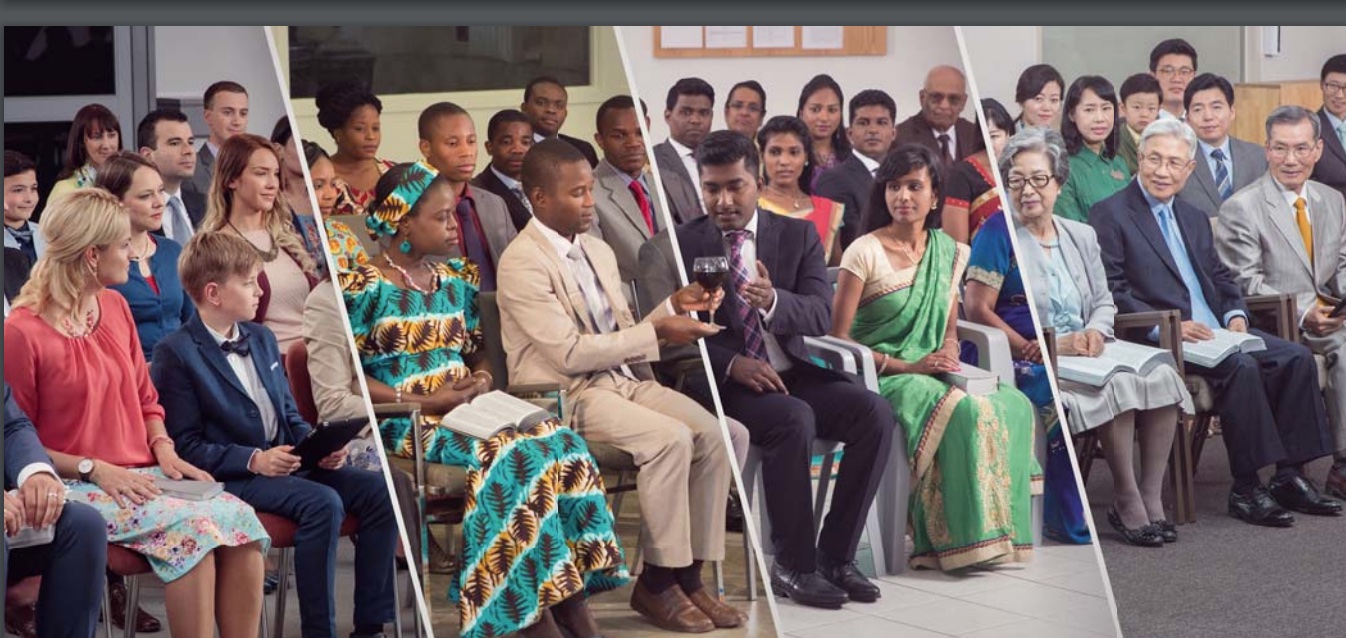
Image Attribution: Watchtower Study 2018 Jan p.12
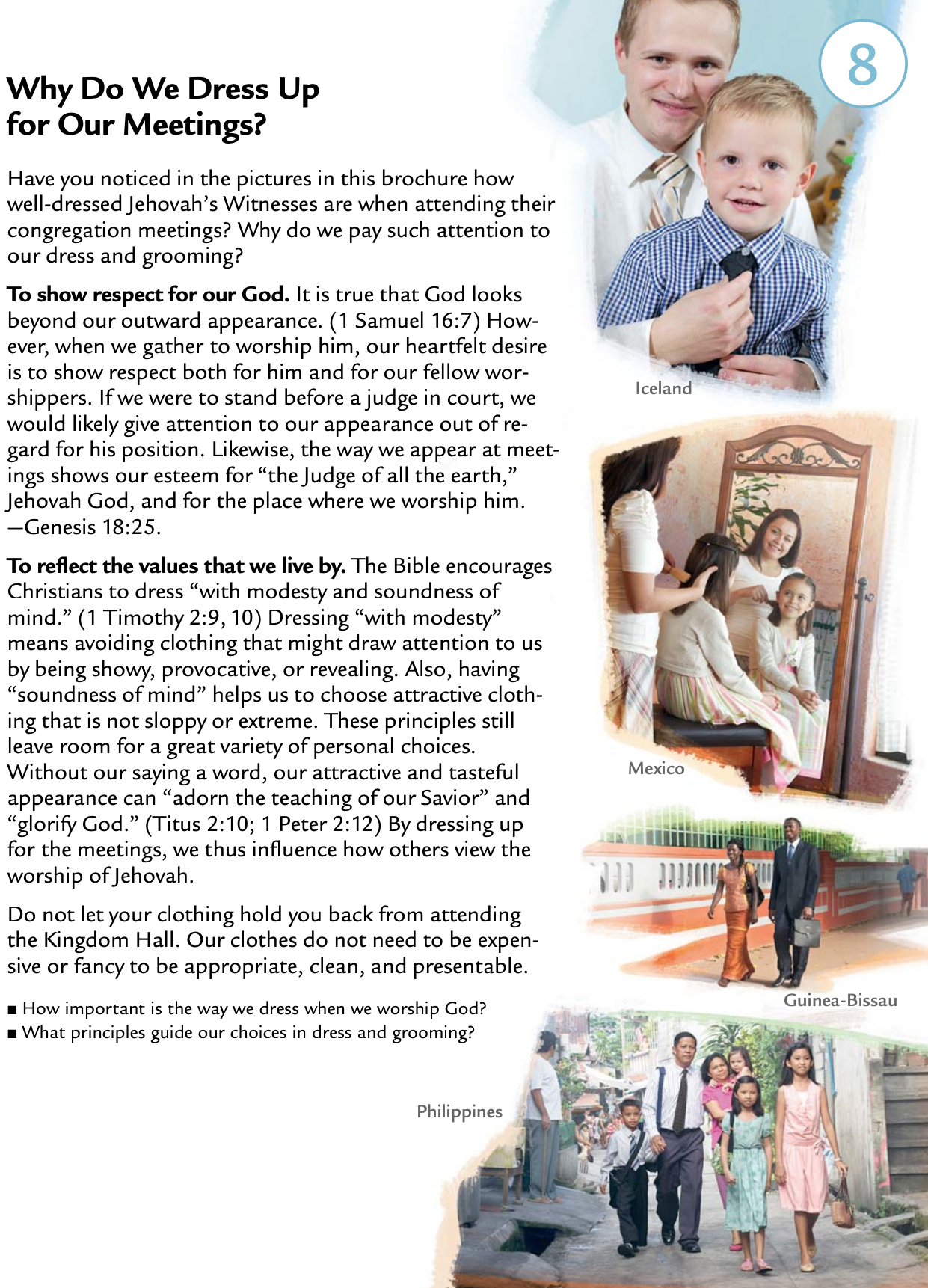
Image Attribution: Who are doing Jehovah's Will Today? (2019) p.8
The image above shows a brother wearing a suit and tie in the streets of Guinea-Bissau, and another wearing a tie in a Philippines slum. The same page advises not to be showy or provocative.
"Dressing "with modesty" means avoiding clothing that might draw attention to us by being showy, provocative, or revealing. Also, having "soundness of mind" helps us to choose attractive clothing that is not sloppy or extreme." Who are doing Jehovah's Will Today? (2019) p.8
Guinea-Bissau and Philippines are both tropical countries. Guinea-Bissau is also one of the poorest countries in the world, with more than two-thirds below the poverty line as of 2021, and wearing a suit and tie is not modest, but showy.
A few images have appeared showing more culturally appropriate clothing, such as on the cover of the September 2016 Watchtower, where a Fijian brother is shown witnessing in a traditional sulu and business shirt, without a tie.

Image Attribution: Watchtower September 2016 cover
It is difficult to not be cynical about the purpose behind this image with its inclusion of an ipad. In 2016, only 17% of Fijian adults had a smartphone (smartphone penetration), and hence few Fijians would have seen an ipad. Preaching with an ipad in remote parts of Fiji epitomizes showy.
Casual Clothes
Jehovah's Witnesses consider they represent Jehovah as his "ministers" at all times, hence casual clothing must also be modest.
"As God's ministers, therefore, we understand that our getting dressed is not just a matter of putting on something comfortable that we like. The principles that we glean from God's Word should move us to avoid wearing clothing that is tight-fitting, revealing, or sexually provocative. That would rule out wearing clothing that exposes or accentuates private parts of our anatomy. Nobody should feel uncomfortable or forced to look the other way when seeing how we are dressed." Watchtower 2016 Sep Study ed. p.18
Watchtower images depict Jehovah's Witnesses following their excessive and inappropriate standards of dress for casual activities, such as wearing business trousers and shirts whilst engaged in sport.
Watchtower 2013 Jun 15 Study ed. p.14
The Governing Body feel authorised to criticize fashion, regardless of whether there is any religious connection.
"Before jumping to the conclusion that you will "die" without that new pair of sneakers or that compact disc player, try being coolly analytic. Ask yourself: 'Do I really need this? Does it serve a practical purpose? Is what I already own sufficient?' Be particularly leery of advertisements that promote prestige of ownership." Awake! 1999 Mar 22 p.13
Watchtower condemns the fashion industry, and attack clothing as fundamental as sneakers as "fad" fashion. The Governing Body even manage to find a way to induce fear through fashion choices, applying "God is going to judge you for whatever you do" to teenage fashion choices.
"The Bible does not condemn youthful behavior. In fact, it says: "Young people, enjoy your youth. Be happy while you are still young. Do what you want to do, and follow your heart's desire." However, the Bible follows up that advice with this caution: "But remember that God is going to judge you for whatever you do." (Ecclesiastes 11:9, Today's English Version) In view of this sobering advice, how should a Christian youth respond to the latest fads? Should you be the first to jump on the fad bandwagon?" Awake! 1994 Nov 22 p.15
Androgyny, Metrosexuals and Tight Pants
Androgyny combines masculine and feminine characteristics and has existed throughout history. Paul Poiret and Coco Chanel are credited with popularizing androgynous clothing fashion after the end of World War 1.
In the 1980's, Watchtower became outspoken against the androgynous or unisex look.
"For example, the androgynous look, recently popularized by certain rock singers, blurs the line between the masculine and the feminine by using makeup, hairstyle, and mannerisms borrowed from the opposite sex. It is not sensible to adopt such a style just because it is popular with certain groups. And note in the Bible what Deuteronomy 22:5 states on this matter." Awake! 1987 Feb 8 pp.17-18
"The Law showed Jehovah's strong feelings against clothing that does not make clear the distinction between male and female - what has been described in our day as unisex fashion. (Read Deuteronomy 22:5.) From God's stated direction about clothing, we clearly see that God is not pleased with styles of dress that feminize men, that make women look like men, or that make it hard to see the difference between men and women." Watchtower 2016 Sep Study Ed. p.15
In 2007, Metrosexuality was labelled as blurring "the line between gay and straight." The article takes its source quote out of context whilst inaccurately conflating sexual preference with fashion sense.
""Metrosexuality" - a lifestyle in which men give excessive attention to themselves and particularly their appearance - has done much to blur the line between gay and straight. According to the man who reportedly coined the term, the metrosexual "might be officially gay, straight or bisexual, but this is utterly immaterial because he has clearly taken himself as his own love object and pleasure as his sexual preference."" Awake! Feb 2007 p.30
Anthony Morris has been particularly vocal about homosexuality, metrosexuality and tight pants since being appointed to the Governing Body in 2005, to such extent that his views on tight pants are meme-worthy.
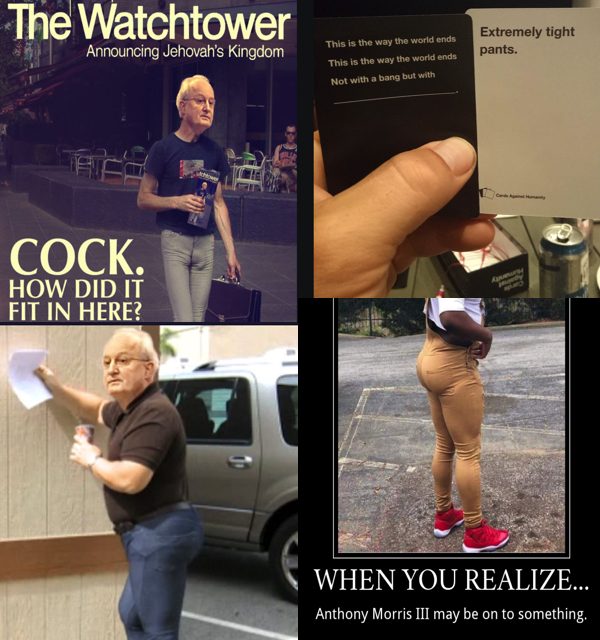
Morris targetted "extremely tight pants" during a comment to Rome Bethel on 20th January 2014 as a disgusting, homosexually inspired, "metrosexual" fashion.
The Circuit Overseer program for elders in 2015/16 contained a section explaining that brothers sporting a metrosexual look of tight fitting clothing, or sisters with revealing or tight clothing, are excluded from qualifying for Bethel, and may even be excluded from preaching in the ministry work.
"Any individual who manifests the aforementioned extremes in dress and grooming or who displays gender-blurring characteristics should not be recommended for Bethel service or the School for Kingdom Evangelisers. Furthermore, if the body of elders agrees that a brother or sister is blatantly and deliberately ignoring repeated counsel, and his or her dress and grooming is disturbing to the congregation, the elders may determine that the person no longer qualifies to share in the ministry." Circuit Overseer Meets With Elders and Ministerial Servants Program for September 2015 Through February 2016
In 2016, a Watchtower image shows elders counselling a brother in a business suit because the cut of the legs is considered too tight.

Watchtower 2016 June study edition p.9
The level of control is concerning when a suit and tie results in criticism and counselling.
Children
The excessive concentration on clothing is extended to children. The children's cartoon video Be Good in the Ministry discusses clothing appropriate for Jehovah's Witness children when preaching.
"Personal Appearance. How we look is very important, because we represent Jehovah. Getting ready for the ministry, we need to make sure our appearance is saying the right things. Jehovah wants us to be well arranged and modest. What that means is that we look and smell clean. Our clothes fit well, but not too well. Our hair is done, and we aren't drawing too much attention to ourselves. Looking sharp my son." Become Jehovah's Friend, Lesson 32: Be Good in the Ministry 2018-12-03
The Governing Bodies' unhealthy obsession with tight pants carries over into this video, sexualising young Jehovah's Witness children with the out of place comment that they should not be wearing tight clothing.

Image Attribution: jw.org Lesson 32: Be Good in the Ministry
Appropriate clothing for Jehovah's Witness children when preaching is depicted as wearing a bowtie. Is a bowtie on a boy cute, clown-like, or a century out of fashion?
Lesson 32 includes an accompaning activity for children to choose appropriate clothes for preaching. The correct choice is a dress for Sophia and tie for Caleb.
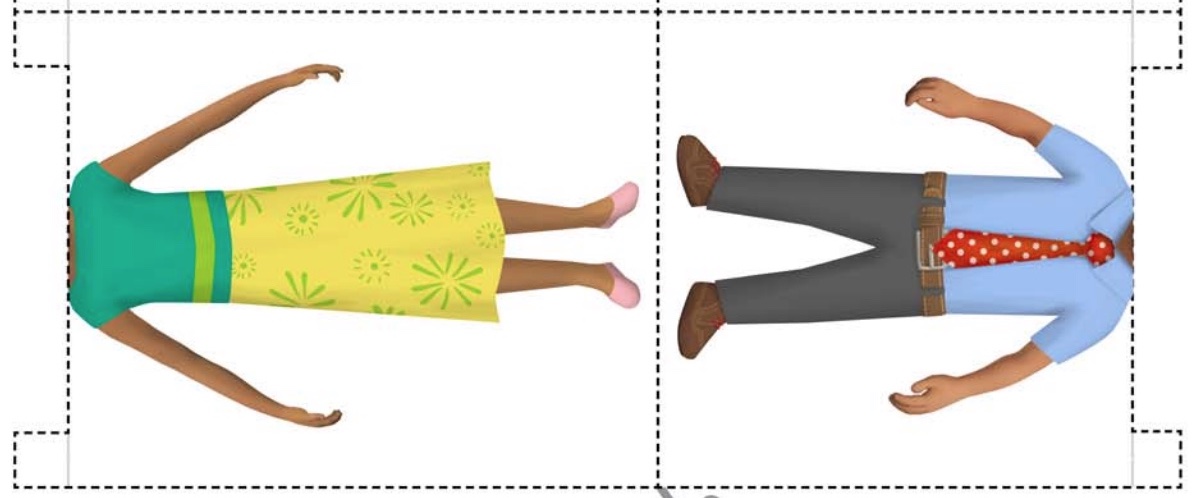
Image Attribution: jw.org Activity: Time to get ready!

Mural Australia Bethel - 2019
Regardless of the culture, Jehovah's Witness boys are depicted wearing Western style ties and suits to meetings.

Image Attribution: Who are doing Jehovah's Will Today? (2019) page 7
Beards
Perhaps one of the most unusual victims of Watchtower's fashion police is the beard. A beard is natural and encouraged in the Bible, yet as discussed at Beards and Jehovah's Witnesses, was strongly discouraged for Jehovah's Witnesses for over a century, only becoming allowed in 2023.
Excessive Control
The September 2016 Watchtower article "Does Your Style of Dress Glorify God?" states Jehovah's Witnesses should feel grateful they are not be burdened with detailed regulations on clothing.
"How grateful we are that Jehovah does not burden us with detailed lists of regulations about our dress and grooming." Watchtower 2016 Sep p.21 par.18
This is a surprising statement, considering how pedantic and controlling Watchtower is regarding dress and grooming. Ironically, prior to this quote, the article includes the following "detailed lists of regulations" against styles that are unisex, provocative, overly casual, revealing or popular fashion.
"From God’s stated direction about clothing, we clearly see that God is not pleased with styles of dress that feminize men, that make women look like men, or that make it hard to see the difference between men and women." Watchtower 2016 Sep p.18 par.3
"The principles that we glean from God’s Word should move us to avoid wearing clothing that is tight-fitting, revealing, or sexually provocative. That would rule out wearing clothing that exposes or accentuates private parts of our anatomy." Ibid p.18 par.5
"Even as we check in and out of a hotel, as well as when we enjoy leisure time before and after convention sessions, we want to avoid an appearance that is overly casual or slovenly." Ibid p.19 par.8
"Hence, our brothers and sisters appreciate it when we refrain from wearing clothes that are so tight or so loose that they are revealing. (Job 31:1) Also, when relaxing at the beach or at a swimming pool, the style of swimwear we use should be modest." Ibid p.20 par.12
"Many stores cater to popular fashions, so it may take more time and effort to find modest skirts, dresses, and blouses or suits and slacks that are not too tight." Ibid p.21 par.16
"In other cultures or localities, beards are not the custom and are not considered acceptable for Christian ministers." Ibid p.21 par.17
Why do a group of religious leaders feel it necessary to impose strict rules regarding clothing? The Governing Body are predominantly old white men, based in America, with no comprehension of American corporate standards, let alone global cultural attire.
It is imperative to comprehend that the power of coercive religious groups is through control. Watchtower rules about beards, ties and dresses have no Scriptural grounding. These are identifiers by which Jehovah's Witnesses can judge how compliant other members are, and used to judge "worldly people" that do not conform to their strict dress codes.
Written November 2013, latest update January 2026.
![]() Paul Grundy 2005 - 2026
Paul Grundy 2005 - 2026


